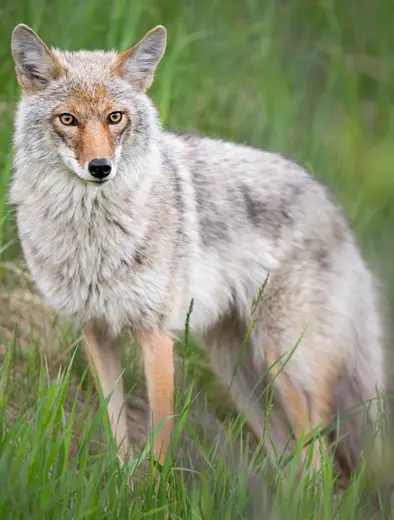Coyotes typically have fur colors ranging from gray to beige to brown, and can sometimes even be completely black or white. But it’s not often you find a pure white coyote.
In fact, you may not even be aware that white coyotes even exist. Today, we will discuss the question: Are white coyotes rare?
Table of Contents
- White Coyotes are Incredibly Rare
- Albino Coyotes Are Rarer Than Other White Coyotes
- Most “White Coyotes” Are Actually Light-Colored Coyotes
- White Coyotes are More Common in Specific Areas
- How Common are Black Coyotes?
- Conclusion
White Coyotes are Incredibly Rare
While coyotes often have white patches of fur, finding a pure white coyote is not common at all.
When white coyotes are spotted, they often make headlines in local journals, as this one in the Portland Press Herald did when it was found in Maine.
That white coyote was one of two spotted in the state in a few years, and there have probably been more sightings that weren’t reported. Considering there are 15,000 coyotes in Maine alone, white coyotes are pretty rare, but they aren’t unicorns.
These rare coyotes are likely white because of a random mutation in their pigment gene.

It’s not a beneficial mutation – hunting and hiding from predators is probably a lot harder with bright white fur – so the gene doesn’t spread through coyote populations.
Another reason coyotes may be all white is that they’re albino. Like all animals, coyotes can be born without the ability to produce pigment, making their fur completely white, and their eyes, nose, and skin light pink. But this doesn’t happen very often.
In addition to this, coyotes are simply reclusive creatures in general. Aside from the early morning or night, it is uncommon to see coyotes in general.
In fact, coyotes are so elusive that many people wonder if they only come out during certain times, such as a full moon.
Albino Coyotes Are Rarer Than Other White Coyotes
Unable to produce pigment, albino coyotes are completely white and often blind, leading to a low survival rate.
Like other albino wildlife, the frequency of albino coyotes is likely around one in 20,000 to 300,000 individuals – so it’s very unlikely you’ll ever come across an albino coyote, but it can happen.
Most “White Coyotes” Are Actually Light-Colored Coyotes
Some coyotes look white from far away, but upon a closer look have a gray tone to their fur, and tinges of yellow around their snout, ears, and back. Coyotes with these colors are more common than coyotes that are all white.
But even these light-colored coyotes are rare when compared to their darker gray and brown counterparts. Their pelts are often valued more highly since lighter fur is more desirable for clothing.
These lighter colors are more common on coyotes’ winter coats, in cold northern areas. When they molt their fur in April, May, and June, their fur becomes darker, often tipped with black.
But the throat, chest, and belly of most coyotes tend to be light or white in color.
Related: How Much Do Coyote Pelts Sell For?
White Coyotes are More Common in Specific Areas
There’s a group of white coyotes that are known to be living in northeastern Canada. Six coyotes in Newfoundland were found to be completely white, with only a few hints of tan color on their throats and ears.
The researchers who studied them found that they all shared a genetic trait that made them white, and it was probably inherited from a domestic dog.
At some point, one or more coyotes cross-bred with a golden-retriever, introducing a new gene into the coyote population that leads to white fur.
Because Newfoundland has long and snowy winters, being a white coyote could actually be a beneficial trait.
In warmer areas, a stark white coat of fur is likely a burden, as it makes for lousy camouflage when hunting prey. But in snowy areas, it may do the opposite and provide more camouflage.
Afterall, these white coyotes look almost like large arctic foxes. Even these northern white coyotes are uncommon, though: only 6 out of over 6000 coyotes were found to be all white. It doesn’t seem to be a fur color that’s very popular among coyotes.
How Common are Black Coyotes?
Coyotes that are completely black are also an uncommon find, but not as rare as white coyotes.
Numbers of black coyote sightings in some areas, such as Georgia, have reached up to 2 to 3% of the population, but in most places they are less common than that. Like white fur, it’s likely that the gene for black fur came from a domestic dog.
Conclusion
If you’ve spotted a white coyote, report it! White coyotes are a rare find. No one’s sure how many are actually out there, but the fact that they aren’t seen very often suggests they’re quite rare.





